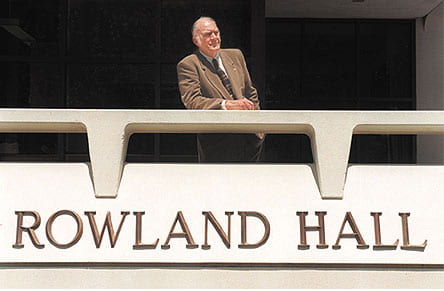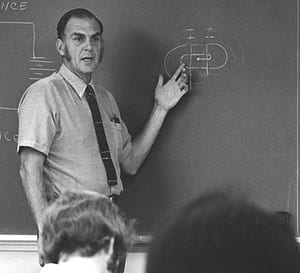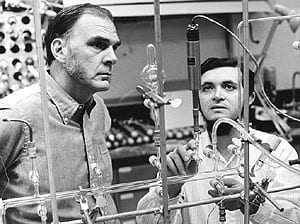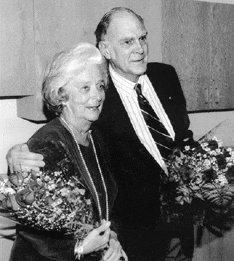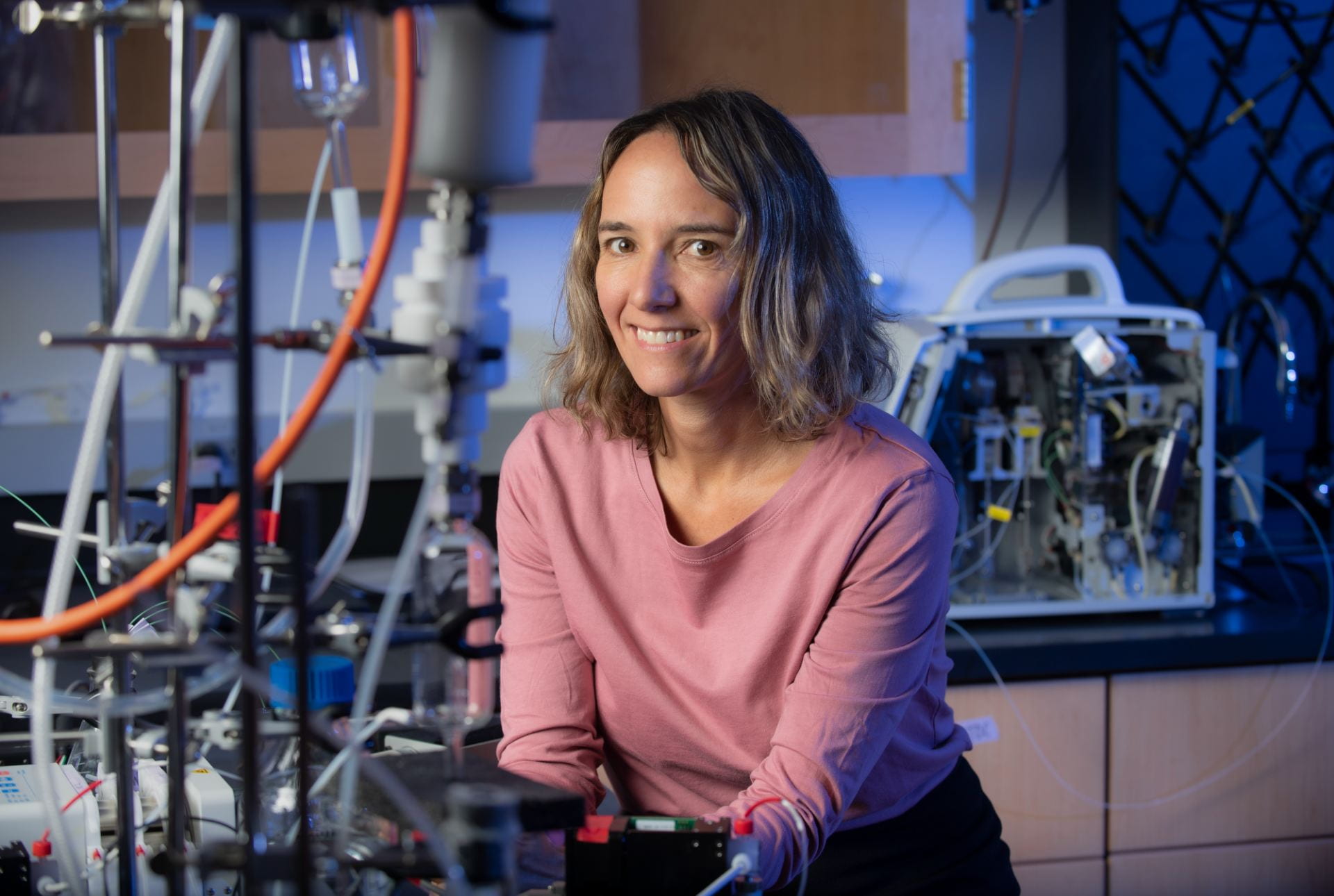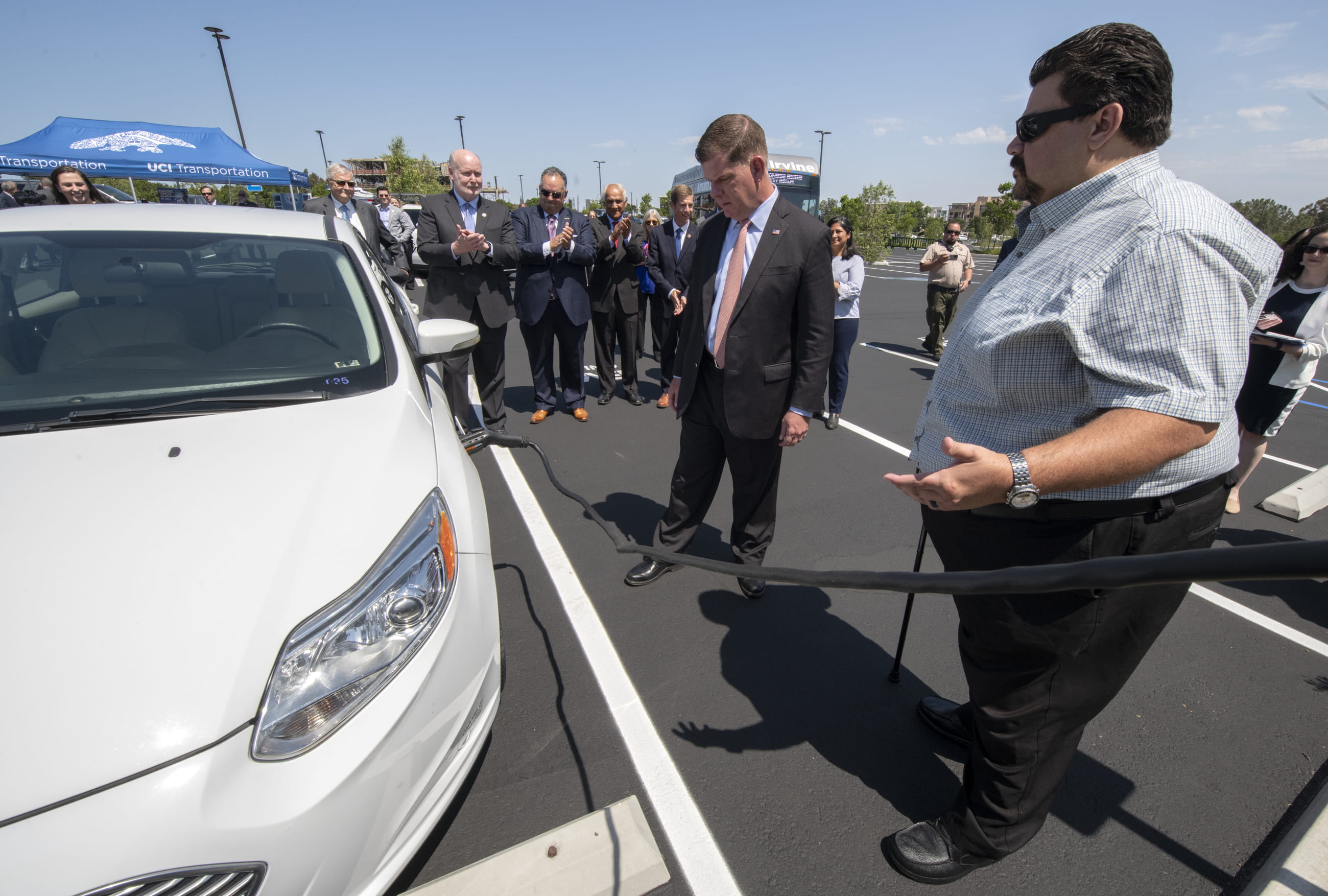A modern Galileo
How UCI chemist F. Sherwood Rowland saved the world
Frank Sherwood Rowland says his defining intellectual characteristic is curiosity. In retrospect, the UC Irvine chemist and former baseball star was a natural to win the Nobel Prize. Born within shouting distance of Ohio Wesleyan University where his father was chairman of the mathematics department, he developed into a math genius himself. After finishing high school at 15 and graduating from college with a triple major in chemistry, physics and mathematics, he went on to graduate school at the University of Chicago, that great Midwestern nursery of Nobel Prize laureates.
After receiving his Ph.D. in 1952, Rowland taught at Princeton and the University of Kansas, scampering up the academic ladder while making what Professor James Anderson of Harvard University calls “profound contributions to the science of kinetics and molecular interaction.” In 1964, the successful, 37-year-old professor was offered his dream job and came west to help found the University of California, Irvine.
Rowland built UCI’s chemistry department from scratch and served as its chairman for six years while continuing to do notable research. The big discovery came in 1973 when he and post-doctoral student Mario Molina discovered that Right Guard was ruining the planet. Specifically, they figured out that chlorofluorocarbons (CFCs), chemicals then widely used as refrigerants and aerosol propellants, were eating away at the ozone layer in the upper atmosphere, exposing people to increasing amounts of cancer-causing radiation.
It was a vital discovery. When Rowland was awarded the Nobel Prize in chemistry 21 years later for his part in making it, the award committee said that he may have “saved the world from catastrophe.” And yet that discovery, in and of itself, will probably turn out to be only a minor part of Rowland’s overall contribution to the future well-being of earth and its inhabitants.
Just as important is how his discovery fundamentally altered the way scientists view the world, leading to the discipline of earth sciences and bringing the intelligence of science to bear on public policy.
When science emerged from the Enlightenment, it was a unified discipline called natural philosophy. Scientists tried to understand physics and chemistry and biology in conjunction with each other. During the 20th century, science became increasingly specialized, splitting into distinct fields with rigid academic walls between them. This specialization made many of the great scientific discoveries of the past 100 years possible. By taking a narrow view, researchers were able to look very deeply into the mysteries of reality. Yet many scientists lost sight of the bigger picture, of how their specific revelations fit into the pattern of life on earth. Most often, physicists no longer know what chemists or biologists are doing. They don’t have a chance to see how their discoveries might mesh with discoveries in other disciplines to help or hurt the environment. Rowland’s melding of meteorology and chemistry and his realizations about the worldwide effects of CFCs helped reunite science and redirect its vision outward from the test tube to the biosphere.
“His work was an enormous leap forward,” says Susan Trumbore, a professor in UCI’s department of Earth Systems Science. “He invented a new kind of science, and we will never look at the world the same way again. Whenever we are doing experiments in the lab or field we are thinking of the larger picture, of how the results fit into and impact the interdependent global environment. It is easy to forget how new that kind of thinking is. Because of Rowland and a few others like him, globalism is a natural concept to scientists of my generation.”
“Prior to the 1970s, the idea that people with little spray cans could affect the global environment seemed preposterous to almost everyone,” says UCI Chancellor Ralph Cicerone, a chemist who collaborated with Rowland on the CFC problem. “By showing that long-lived chemicals can go anywhere, from way up in the atmosphere to down in the ocean, Rowland and Molina changed the way we see the world.”
The global ban on CFCs did not come without a bruising fight. Rowland faced fierce opposition to his ideas from chemical industry scientists, government figures and even other academic chemists. Corporations and conservative ideologues attempted to destroy his reputation as a serious scientist rather than accept his findings. In the end, his perseverance in standing his ground and insisting that others understand the danger of inaction blazed a trail for other scientists to follow. The manufacturing of CFCs was finally banned by the leading industrial nations in 1987.
“There was tremendous controversy about his ideas for a number of years,” says Harvard’s Anderson. “He showed great courage and fortitude and was absolutely in the forefront of pushing science into public policy.”
At 72, Rowland, called Sherry by most of his friends and colleagues, is an imposing, senatorial figure. His 6-foot-5-inch frame is slightly stooped beneath the weight of controversy and honors – including 10 honorary doctorates from universities in three countries – but the man is still sturdy. He and his wife, Joan, have lived in Corona del Mar for 36 years, watching as the cow pastures around their home filled up with houses, and for decades he stayed in shape by swimming in the ocean each day. Since becoming foreign secretary of the National Academy of Sciences, a job that requires extensive international travel, he stays active mostly by walking. It is a ruminative form of exercise perfect for deep thinking that he can indulge in wherever in the world he happens to find himself and it seems to do the job. It is still easy to picture him as the college athlete and minor league baseball player he was in the late 1940s.
I knew ahead of time that he is a big man and identified him at a distance as he ambled toward me along a blue-tiled hallway on the fifth floor of the chemistry building, passing emergency showers and eye-washing stations, filling up an increasing amount of the space between the concrete block walls. There is a little bit of John Wayne in his walk, a falling forward of the upper body, one shoulder slightly in the lead, legs playing catch-up. Grasping the big, basketball player’s hand he extended, I made a mistake.
“Good to meet you, Professor Rowland,” I said, mispronouncing the middle part of his name, so that it rhymed with ‘now.’
“Rowland,” he corrected me sharply. “Long oh.” Succinct and to the point. I don’t think he was offended that I didn’t know the correct pronunciation of his name. He is simply a man who isn’t comfortable with error. The quick warning shake of his head as the wrong word came out of my mouth made me feel a sense of solidarity with the several generations of students whose work has passed under Rowland’s eye.
The eyes are dark and deep set beneath bushy gray eyebrows and a high forehead. The nose is straight and broad. The chin resembles the butt-end of a brick, slightly rounded, and gives an inkling of how he managed to face down congressional committees and skeptical scientific conferences when his ideas were regarded as crackpot nonsense. Altogether, it is a handsome, determined face, capable of looking sly, judicious, severe and kind in a grandfatherly sort of way during the course of an interview.
Rowland has been turning out Ph.D.s for four decades, peopling the world first with radiochemists then with atmospheric chemists. Don Blake, now a chemistry professor at UCI, is one of them.
“I came to UCI in May 1978 and Sherry was the first person I talked to when I walked into the chemistry department,” Blake says. “He was wearing sandals and shorts and I remember thinking two things – first that he was huge and second that he didn’t look the way I expected the chairman of the department to look.”
Blake joined Rowland’s research group, earning his Ph.D. in 1984. He stayed on to work with Rowland first as a post-doc, then as a specialist and research chemist, gradually taking over daily management of the group. In 1998, Rowland helped engineer his appointment as a full professor.
“I don’t worship the ground he walks on, or anything,” Blake says. “He has flaws just like you and me, but I have never regretted a single moment that I’ve worked with Sherry Rowland. This is a man who is a real role model as a scientist and a person, a man who is good for his word. We disagree sometimes about the direction our research should take, and I have probably called him a knucklehead more often than anyone else, but I have never doubted that he had my best interest at heart.”
Blake places special emphasis on Rowland’s intellectual honesty and generosity. “When Sherry gives a seminar, he doesn’t say ‘I did this and I did that.’ He says ‘Don did this, a post-doc in my group named Isobel did that, and one of our grad students did this other thing.’ That kind of generosity is very rare in science.”
Clean-Up Hitter
I interviewed Rowland in the same corner office where he and Molina carried out the discussions that led to their CFC discoveries. He was generous with his time, especially considering the many demands on it, meeting with me for a total of five hours and talking on the phone several times. But he isn’t the easiest man in the world to interview. Having met many, many people of various kinds in his long career, he was reserved at first, taking a wait-and-see attitude toward an unknown reporter. As our interviews progressed, he was more forthcoming and spontaneous, slight smiles expanding into chuckles, but he continued to answer different questions than the ones I asked when it suited him. He also displayed an alarming tendency to veer away from the subject of Nobel Prize-winning science to talk about his athletic career.
Because of his fast progress through school, he was usually younger than most of his classmates. By the time he started college, he was younger than all of them.
“Because of the age difference, I ended up being something of a loner,” he says.
Sports were a way to fit in and be noticed for something other than his brilliant mind. A growth spurt in his early teens caught the attention of his high school math teacher who also happened to be the tennis and basketball coach.
“I started playing on the tennis team when I was 13. When I kept on growing, they realized I was probably going to be the tallest boy in the school by the time I graduated and they recruited me to play basketball, too.”
Rowland continued to play both sports at Ohio Wesleyan and during a brief stint in the Navy at the tail end of World War II. But it was at the University of Chicago, a place of almost mystical significance in Rowland’s life, that he came all the way into his own as an athlete.
“I found out when I got to the university that they had special eligibility rules and that allowed me to play varsity basketball even though I was a graduate student. So I did, and then near the end of the basketball season some of the other players were talking about the baseball season that was coming up. They were going to make a southern trip – play six games down there – so I went along and had a good spring trip and came back as the first baseman and clean-up hitter.”
After his second college baseball season, Rowland’s skills earned him a place on a minor-league team in Oshawa, Canada. Several weeks after he joined the line-up, the manager was fired for waffling a slide signal that caused a player to break his leg. Somebody savvy named Rowland as the replacement manager. Utilizing his growing self-possession along with the awesome quantitative abilities he considers to be his second most important mental attribute, the 21-year-old graduate student proceeded to manage his rag-tag bunch of American and Canadian players all the way to the semi-pro championship of Canada.
“We probably weren’t the best team in the series,” Rowland says, displaying his habitual determination to keep everything clear and above board. “But we had a very good tournament and managed to win the championship.”
Rowland’s athletic digressions worried me because I was there to probe a great scientific mind. But they were entertaining and, in the end, illuminating. His fondness for talking about his sports career shows how important those successes were to a young intellectual and how much of a part they still play in his self-image. More important things than baseball were going on at the University of Chicago in the late 40s, though, and Rowland got around to talking about those things, too.
Rowland’s father went to graduate school at the University of Chicago where he met and married Rowland’s mother who was an undergraduate there. Following suit, Rowland met and married his wife while he was working toward his Ph.D. in chemistry. His daughter, Ingrid, is now a member of the faculty. In academic circles, the University of Chicago has a mystic and intellectual seriousness about it that exceeds nearly every other American university.
“In my parents’ minds there was only one university,” Rowland says. “Chicago was the only graduate school I applied to. Fortunately, I was accepted.”
When Rowland won his Nobel in 1995, he was the 70th person from the University of Chicago to receive the award. When he arrived in the fall of 1948, the place was teeming with scientific stars – nuclear physicists and radiation chemists fresh from the Manhattan Project. Half-a-dozen former or future Nobel Prize-winners were teaching there. Rowland’s randomly-assigned graduate advisor was Willard F. Libby, a radiochemist who had just discovered the carbon-14 method of dating archaeological and geological objects, work for which he would receive the Nobel in Chemistry in 1960.
“So, without realizing it, I was assigned to a man who had just done Nobel Prize-winning work,” Rowland says with a shrug. “He was sufficiently charismatic that I never talked to anyone else when it came time to do my research. I asked him what kind of problems he had to work on and he gave me something. I didn’t have any ideas of my own at that time.”
Libby set Rowland to work doing “hot atom chemistry,” charting the movement and interactions of atoms freshly created by nuclear reactions. Such atoms are much more highly energized than normal atoms and chemists learn new things about chemical law and the nature of matter by studying them.
The work earned Rowland a Ph.D. in chemistry in 1952 and got him a job as a lecturer at Princeton. After four years in the Ivy League, he went to the University of Kansas as an assistant professor and built his first research group, continuing to probe the mysteries of hot atoms. By the time he was 36, he was a full professor with more than 75 scientific publications and a reputation substantial enough to attract the attention of the greatest public university in the world. When the University of California decided to build a futuristic campus in central Orange County, they drafted Rowland to found the chemistry department.
When he arrived in August 1964, there were no buildings or students. The city of Irvine was just a gleam in the eye of an urban planner.
“Looking out from the hill the chemistry building is built on toward where the 405 is now, there wasn’t a speck of green,” Rowland says. “No lawns or trees or houses. Nothing but brown ranch land.”
Because of Rowland’s work, the chemistry department was built with a nuclear reactor that still operates today. As the university took shape around him, he hired the first 11 members of the chemistry faculty and began teaching the university’s inaugural class. After six years, he stepped down as department chairman to concentrate on his research, which had shifted somewhat from radioactive chemistry to photochemistry, the chemistry of reactions caused by light.
Rowland’s research had been funded by the Atomic Energy Commission (AEC – now part of the Department of Energy) since 1957. By consistently producing results, discovering new and often unexpected chemical reactions, he had won enough of the commission’s confidence to be allowed wide leeway in the nature of his experiments.
“I had a reputation as someone with a knack for wandering into places where unpredictable things were lying around,” says Rowland. “If I wanted to explore something that seemed unrelated to atomic energy and unrelated to anything that people had identified as an area of interest, they let me do it because I had always used their money productively in the past.”
The Discovery
In early 1972, he read about the work of an English scientist, James Lovelock, who had proposed using chlorofluorocarbon molecules as markers to study the movement of the atmosphere. CFCs, which were invented in 1928, the year after Rowland was born, were designed to be inert – long-lasting and slow to react with other chemicals. The fact that they didn’t react with the substances that made up deodorant, insecticide or shaving cream made them ideal aerosol propellants. Their long-term stability made them useful as refrigerants – temperature transfer agents – in the closed systems of air-conditioners and refrigerators.
Rowland’s curiosity was stirred. He began to wonder what became of these exceptionally stable chemicals once they were sprayed out of cans or leaked from cooling systems. Where did they go? How were they finally eliminated from the environment?
For the rest of 1972, he turned the problem over in his mind when he had a spare moment from his other research, considering possibilities. When he submitted his budget to the AEC in early 1973, it included a request for money to study the final disposition of CFCs. The money was awarded and Rowland continued to ruminate. Then, on Oct. 1, 1973, Molina arrived at UCI with a brand new Ph.D. from Berkeley looking for a chemical puzzle to solve. When Rowland offered him a choice of projects to work on, he chose the CFC problem.
Over the next two months, the pair systematically investigated all the ways that CFCs might be destroyed on or near the surface of the earth.
“It was sort of boring work.” Rowland says. “We had to calculate or look up the amount of various chemicals in the atmosphere and then go through chemical journals to research possible reactions of those chemicals with CFCs. Gradually it became clear that CFCs would not begin to break down until they circulated up into the stratosphere where they could absorb enough solar radiation to make them reactive.
“That was the first break point. We had some interesting calculations and stopped to consider if we should publish our results. We decided to hold off and look at the ramifications of the breakdown of CFCs in the upper atmosphere.”
Pushing on through several more stages of investigation, doing classic, systematic science, Rowland and Molina determined that the CFCs would take 50 years to break down, releasing a chlorine atom and leaving a molecular fragment. Both the chlorine atom and the fragment would then react with the ozone molecules in the stratosphere, starting a catalytic chain reaction that would go on for another 50 years. In the end, each chlorofluorocarbon molecule that bounced off of someone’s underarm in New Jersey would destroy 100,000 ozone molecules. Further calculations showed that this process would significantly reduce the ozone layer, endangering life on earth.
The “wait a minute, if this is true . . .” realization came in early December 1973. Rowland and Molina looked at each other, took a deep breath, and redid all of the calculations over a period of three days, searching for an error that would invalidate their results. There was no error.
When he came home from the university looking preoccupied, Rowland’s wife asked him how the work was going. “The work is going very well,” he told her. “But it may mean the end of the world.”
Public Policy Advocate
Rowland says that moment of discovery, not winning the Nobel Prize for the discovery, was the most satisfying and exciting moment of his professional career. Even with its frightening ramifications, it was the kind of moment every scientist lives for, hopes for, dreams of. What followed sometimes seemed more like a nightmare.
One thing that made Rowland and Molina’s discovery especially remarkable was that they weren’t atmospheric chemists. In fact there was no science of atmospheric chemistry at that time. There were chemists and there were meteorologists. Rowland and Molina and a few other people around the world were inventing a new discipline as they went.
“We were real interlopers in the atmospheric field,” Rowland says. “There is a great advantage in that – a freshness of vision – but there is huge danger, too. Meteorologists are likely to resent chemists trespassing in their area and there is a real possibility that you are unaware of something fundamental that when others hear your idea they will be able to shoot you down immediately. So for a while we were gong around wondering who had the magic bullet.”
Reaching out to the atmospheric community for corroboration, Rowland came in contact with Cicerone whose research group at the University of Michigan was also looking at how chlorine interacted with stratospheric ozone. Their calculations confirmed what Rowland and Molina suspected, and Rowland and Cicerone began a close collaboration and friendship that continues today.
The dual nature of the science involved in Rowland’s work created problems when it came to publishing. He sent the first paper about the CFC work to Nature, a journal known in the scientific community for its ability to publish interesting work quickly. But the editors had difficulty finding someone who could evaluate both the chemistry and the meteorology in Rowland’s paper. Chemists were uncertain of the atmospheric stuff. Meteorologists didn’t know enough chemistry to judge if the calculations were right. Then, on top of that, the paper, with its earth-shaking revelations, got lost in the magazine’s office when the assistant editor in charge of it went off for a ski vacation in Switzerland and failed to return.
After five months, Rowland called to find out what was going on. The editors rallied and published the paper on June 28, 1974. The result was underwhelming. The following month, Rowland and Cicerone met in person for the first time and discussed the situation.
“His paper had come out in Nature and hadn’t gotten much response and he was wondering if he should call it to the attention of people in the corporations and government,” Cicerone recalls. “He wanted to do that but he didn’t know how to get started. And of course I didn’t either, but we talked about it and tried to figure something out.”
That meeting was the start of pioneering crusade in which Rowland stepped out of the comfortable role of an ivory tower academic and became a public policy advocate. As his efforts succeeded in calling attention to the danger posed by CFCs, he was attacked from several directions at once.
People like to spray things out of cans and CFC manufacturing was a $9 billion-a-year business growing 10 percent annually. The main manufacturers were Dow and Dupont, huge corporations loaded with money and bristling with PR people and scientists. They fought Rowland every inch of the way, sending teams of scientists to heckle him at conferences were he talked about CFCs, ridiculing his science and attacking him personally. At the height of the controversy, the aerosol industry accused him of being an agent of the KGB out to damage capitalism.
Academic scientists weren’t much kinder. It was considered indecorous for a professor to mix it up with the politicians, never mind if the fate of the earth hung in the balance. Rowland was seen by many as a reckless self-promoter endangering the integrity of science. For more than a decade, invitations to lecture at other universities, previously abundant, dwindled to a trickle.
“It was such unusual behavior for an academic scientist – getting involved in so much public activity,” says Cicerone. “University scientists are suspicious of colleagues who do that. They think everyone should stay in the lab and be quiet and never make a mistake. So if you go public the way Sherry did, you damn well better be right or you will be permanently discredited.”
The dual nature of the science continued to present problems, making it difficult for researchers in separate fields to be sure of the overall accuracy of Rowland’s predictions about the long-term results of continued CFC use. Even at UCI, in the department Rowland founded, chemists grumbled about his behavior. Some disliked the controversy while others resented the intrusion of meteorology into their discipline.
Despite the widespread opposition and whatever pain it caused him and his family – something Rowland is mostly unwilling to talk about – the big man from Ohio soldiered on, taking responsibility for his discovery by forcing the world to face the invisible environmental destruction taking place miles above the well-deodorized surface of the earth. He made phone calls and public appearances, wrote letters and papers, testified before committees. He kept pushing.
“Sherry didn’t stop with the science the way most people would have,” says Don Moore, a UCI chemist who has known Rowland for 35 years. “Most other people who might have made the CFC discovery wouldn’t have been able to carry the ball through the minefield of industrial and political opposition he faced.”
Through it all, Rowland maintained the sense of humor and personal integrity he is noted for. He and Moore have a long history of trading practical jokes, and their battle continued throughout the period of Rowland’s trials.
“He is the most unique person I’ve ever met in terms of his sense of humor, his intellectual capacity and his interest in the university,” says Moore. “We’ve had great fun over the years.”
Rowland’s closeness with his wife and two children also helped sustain him. He considers Joan an “honorary co-recipient” of the Nobel Prize and Ingrid and his son Jeff were the first two people he called when he heard from Stockholm.
Turning Point
The first turning point in his battle with the aerosol industry and its political supporters came in 1976. A committee appointed by the National Academy of Science (NAS) to look into Rowland’s claims issued a report confirming the dangers of CFCs and stating that a ban would be necessary.
“After that, it wasn’t just a couple of crackpots crying wolf,” Rowland says. “It was a couple of crackpots and the National Academy of Science.”
Still, opposition was far from over. Some CFCs were banned in several countries but other new ones were introduced and used increasingly in computer component manufacturing. Aerosol industry scientists continued to deny that the ozone layer was being affected by man-made chemicals, issuing reports which attributed measured variations in the stratosphere to natural phenomenon such as volcanic eruptions and the evaporation of chlorine from seawater. With the advent of the Reagan administration and its anti-environmental polices, interest in Rowland’s work diminished further. James Watt, Reagan’s first secretary of the interior, was famous for fighting the environmental movement at every turn. Secretary of Energy Rowdell wasn’t much better. In the early ’80s he made a speech in which he jokingly referred to the idea of aerosols posing an environmental danger in the past tense, the kooky conception of discredited scientists.
This period was the low point of the whole process for Rowland. It began to look like the world would go on making and using CFCs until severe environmental damage had been done. Global warming, crop failures and skyrocketing skin cancer rates loomed. Then something happened that no one, not even Rowland, had expected.
In 1985, British Antarctic Survey team, which had been measuring ozone in the polar region since 1957, announced that a large hole in the protective layer had appeared over Antarctica. The hole fluctuated seasonally, increasing to almost continent size in the fall, and was getting larger each year. The British results finally electrified the world. Several year later, in 1987, 24 nations signed the Montreal Accords, banning many CFCs outright and planning the eventual elimination of the entire class of chemicals.
Since the ban, CFC concentrations in the atmosphere have peaked. According to Rowland, ozone destruction is close to peaking, with the radiation shield over Southern California reduced by about 10 percent in winter, 5 percent in summer. Over the next 100 years the sky should heal itself completely.
Montreal was a great triumph for Rowland. The big chemical companies capitulated and stepped up development of alternate propellants and refrigerant compounds. There is, apparently, a deep-seated resistance in some people’s minds to the idea that what they do affects the global environment, and opposition to Rowland’s ideas never ceased completely.
A small group of protesters picketed against him in Stockholm. More recently, Rush Limbaugh has tried to revive the controversy. But from the Montreal Accords on, Rowland’s sailing was much clearer. From being persona non grata at many universities he began to be recognized as one of the leading scientists of his generation. Nobel rumors began to circulate.
Earth Sciences
In 1989, Rowland helped institutionalize the outward-looking, interdisciplinary science he is known for by working with a handful of other UCI professors to found the Department of Earth Systems Science at the university.
“I was dean of Physical Sciences when the department was created,” says Moore. “Sherry and I and several other faculty members felt like this new type of science would be crucial in the future and we saw that we had a unique opportunity to build something around Sherry’s work. Without his scientific clout, we probably couldn’t have done it.”
“I certainly wouldn’t have come here if it hadn’t been for Sherry,” says Cicerone, who arrived at UCI in 1989 to serve as the first chairman of the new department. “The first eight faculty we hired all had their Ph.D.s in different areas – physics, chemistry, astronomy, oceanography, geology, meteorology and several other disciplines. We felt like we had to break down the specialization and separation between fields to look at the big picture. We have to try and avoid environmental surprises.”
The only complete department of its kind in the world, the Earth Systems Science department at UCI attracts some of the top graduate students in the nation.
“It has been a tremendous success,” says Trumbore. “For a small department, we have a big impact. In 1998, we were ranked No.1 in the nation in terms of how many other scientists cite our papers. We had more citations per faculty member than any other department. That is a very important measure of the significance of our work.”
“The department is very, very highly regarded,” says Moore. “Its future accomplishments are going to be incredible.”
Meanwhile, the chemistry department Rowland founded 35 years ago has built one of the best organic chemistry programs in the U.S. His research group continues to do ground-breaking work in atmospheric chemistry, taking and analyzing air samples from Tasmania to Thailand to downtown Los Angeles, helping chart changes in the air we breathe.
“The atmospheric community considers the work we do at UCI to be of the highest order,” says Blake. “There have been some comparisons to see how accurate the measurements of various groups are and we are always the best. NASA doesn’t fly atmospheric missions without us.”
In 1994, Rowland extended his globalizing activities in a major way, becoming foreign secretary of the National Academy of Sciences. Founded by Abraham Lincoln in 1863 to supply scientific advice to the United States government, the NAS is the nation’s most prestigious scientific organization. As foreign secretary, Rowland works with the leaders of other national academies of science, trying to anticipate and head off environmental problems.
“Increasingly, these problems are global, or at least regional,” Rowland says. “It is essential for scientists and governments around the world to work together to solve them.” In his quest to accomplish that goal, Rowland travels 200,000 miles a year, consulting with experts in many fields, lobbying politicians and power-brokers on six continents. So far in 2000, his work has taken him to Mexico City, Switzerland, England, Australia, Japan, Italy and Israel. He is co-chair of an international group working to establish a permanent interacademy council that will be able to address problems having to do with population, energy, education, water and agriculture on a global basis, just as the NAS does on a national basis in the U.S. At the same time, he remains active in his research group at UCI where he is the Donald Bren Research Professor of Chemistry.
“Even though I run it on a daily basis, our group is still driven by Sherry,” Blake says. “He pops in when he is in town and says, ‘What’s going on?’ He looks over our results and says we need to write this up. Or he comes in and tells me about a mission that is coming up that we need to get in on. Sherry’s continuing involvement really benefits today’s science. When he is out giving talks around the world, he isn’t talking about some great thing he did 25 years ago. He is talking about results we came up with last week.”
Nobel Debris
The chemistry department at UCI is littered with debris from the Nobel Prize event. A picture of Rowland sitting next to the queen of Sweden hangs on a wall in his office. On a bulletin board across the hall, ecstatic clippings from The Orange County Register continue to proclaim the news that a local man has made good in a big way, receiving the world’s highest scientific honor. Down the hall in Baker’s office, airline-size bottles of liqueur served at the awards dinner decorate a book shelf. The chemistry building itself, renamed Rowland Hall in 1996, has become, in part, a memento of the Nobel.
Trace elements of the Nobel also exist in the minds of his friends and colleagues, lighting up their eyes when his name is mentioned. The morning Rowland found out he had won, Blake was the third person he called. Blake was in the shower and Rowland left a typically laconic message on his answering machine: “Don, you may want to listen to the news this morning. I got a call from Stockholm.”
“I still have that tape,” Blake says. “I will die with that message embedded in my brain. When I heard it, I just started crying. My kids were trying to figure out what was going on because they associate tears with sadness, but I was crying for joy.
“I was happy first of all because it couldn’t have happened to a nicer person. Second, because it was very important for the field of atmospheric science. The Nobel was like the committee saying, ‘OK, atmospheric science is now legitimate.’ I was also very happy for UCI and for anyone who had ever been to UCI, especially anyone who had ever been a member of our research group. Our mentor was now a Nobel Prize laureate, and that means a lot.
“I wasn’t the only one affected that way. I saw other faculty members in tears that day. That shows you what kind of friend and colleague Sherry Rowland has been. People would have come and shook his hand even if he had been a jerk, but there wouldn’t have been that joy.”
“Reproduced with permission from OCMetro magazine”
May 18, 2000
